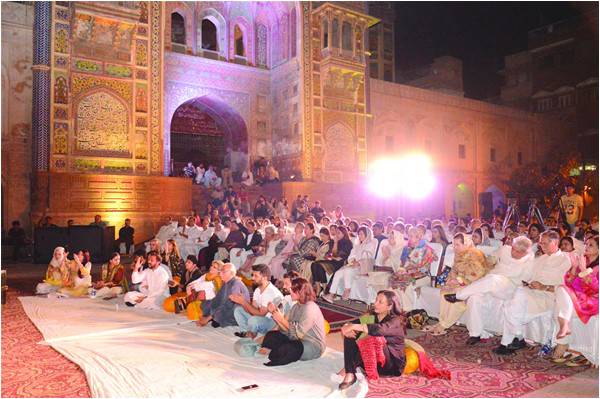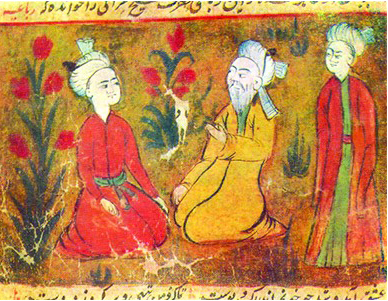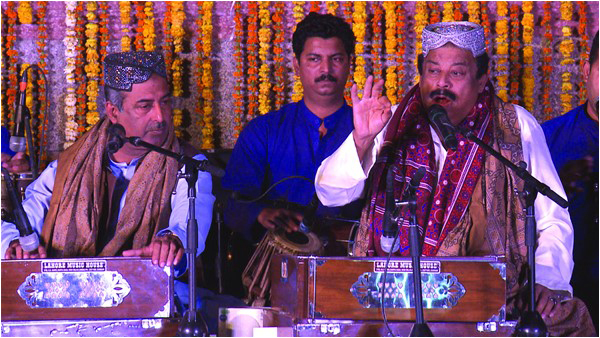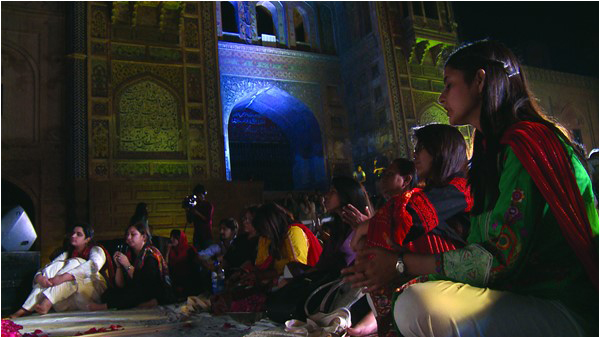
An evening of Mehfil-i-Sama was organized by the Lahore Arts Foundation in collaboration with the Walled City Lahore Authority, at the courtyard of the historic Wazir Khan Mosque to pay tribute to Amir Khusraw. Fareed Ayaz and Abu Muhammad mesmerized the audience at the two-day concert last week. Their rendition of Amir Khusraw’s Persian and Urdu poetry enthralled the large audiences. Their devotion to Khusraw and renditions of his ghazals, ragas and tarana in Desh and Bihag were exquisitely rendered. “Man kunto maula”, “Nami danam che manzil bood”, “Zehaal-e -miskeen makun taghaful duraye naina banaye batiyan”, “Har shab manam futada ba gird e sara e tu”. “Tori soorat ke balhaari Nizam” and “Hazrat Khwaja sang kheliye dhamar” received much applause. They sang “Kahei ko behai bedesh” and “sakal ban phool rahai sarson”, reminding us that Khusraw, too, was moved by and celebrated basant and the spring seasons of this land.
TFT: What is the relevance of Amir Khusraw’s poetry today?
Sabah Husain: Amir Khusraw is one of the most venerated personalities in the Subcontinent and was a great believer in pluralism. He was conscious of his multicultural heritage and attempted to put forward a worldview characterized by inclusiveness and tolerance. Khusraw stands as a major cultural icon in the history of the Subcontinent and its civilization across a span of almost 700 years. He is especially associated with the Ganga-Jamuni culture which draws on the universal values shared by the people of the Subcontinent. He gave a distinctive character to Islamic cultural traditions through his contributions to the fields of classical music, Islamic mysticism and South Asian Sufi music, the ‘Qawwali’. His contributions to Persian literature are substantial. He is also accredited with the development and evolution of Hindavi, in which both modern Hindi and Urdu have their roots. Amir Khusraw was positioned at the juncture of two cultures; his prolific literary output and talent make him one of the most remarkable figures of Islamicate and global cultural history. His poems are recited even today in Pakistan, India, Iran and Persian-speaking regions of Afghanistan and Central Asia.

Both Amir Khusraw and Jalaluddin Rumi were poets of Central Asian origin who deeply influenced the practice of Sufism through their emphasis on the mystical performance of music and dance - and the language in which it was expressed. They were both immersed in local cultures and wrote macaronic poetry, mixing Persian with local languages. Both authored a large corpus of ghazals on themes of love. Khusraw’s poems are thematically both about Ishq-e-Haqiqi and Ishq-e-Majazi.
TFT: What were your main concerns as the curator for this event?
S.H.: Bayad-e-Khusrow was conceived as an evening where his classical poetry was the focus. Primarily, ghazals, manqabat, tarana and some of his most eloquent bandishes. Many bandishes attributed to him are no more; they have perished with the Kheyal gaike. They were sung in the musical construct particular to the musicians singing in the Kheyal gaike format. Khusraw’s immense contribution to the classical music of the Subcontinent is not documented. It is predominantly in the oral tradition that a selection from his repertoire has survived.
Presently Qawwali has evolved and incorporates themes from all genres. Moreover, the qawwals move effortlessly from Persian to Arabic to Khusraw’s Hindavi; stanzas are recited in different languages, also by different poets, employing a unique device peculiar to Qawwali called ‘gerah’, a knot. Since Qawwali has a hybrid construct, the musicians have been able to enrich their repertoire with Khusraw’s texts in various languages.


TFT: How did the audiences at the Lahore Arts Foundation Trust event engage with Amir Khusraw’s poetry? What was the general response and what are your plans for the future.
S.H.: It took many many conversations with Fareed Ayaz and Abu Muhammad to organize this event. I wanted the event to be in a public space and open to students, scholars and to the Qawwali aficionados. The courtyard of the Wazir Khan Mosque created a magical ambience, inspiring both the musicians and the audiences alike. The turnout, especially of younger people, was a pleasant surprise. I thought to myself that many would probably have difficulty understanding the Persian qalam but clearly it resonated deeply with them. Of course, a few may have gone quickly to Google for help with a particular word or phrase!.Not only was the audience attentive to the musicians inside the venue, with the ambience adding that extra something special to the experience, people gathered outside the venue in the streets to listen.
We did face some difficulties and sponsorship was a hurdle. We were advised to ticket the event but I wanted the event to be free for all who could relate to Amir Khusraw’s poetry. Many had traveled from different cities to attend the Mehfil. There are requests from many quarters that this should become an annual event. That is something I would very much want, but sponsorship still remains an issue. I curated this event and organized it with the much appreciated logistical support from WCAL and we received a few generous sponsorships for which I am very grateful. But LAFT still had to dig deep into its own resources for the Mehfil, Bayad-e-Khusrow.
TFT: What is the relevance of Amir Khusraw’s poetry today?
Sabah Husain: Amir Khusraw is one of the most venerated personalities in the Subcontinent and was a great believer in pluralism. He was conscious of his multicultural heritage and attempted to put forward a worldview characterized by inclusiveness and tolerance. Khusraw stands as a major cultural icon in the history of the Subcontinent and its civilization across a span of almost 700 years. He is especially associated with the Ganga-Jamuni culture which draws on the universal values shared by the people of the Subcontinent. He gave a distinctive character to Islamic cultural traditions through his contributions to the fields of classical music, Islamic mysticism and South Asian Sufi music, the ‘Qawwali’. His contributions to Persian literature are substantial. He is also accredited with the development and evolution of Hindavi, in which both modern Hindi and Urdu have their roots. Amir Khusraw was positioned at the juncture of two cultures; his prolific literary output and talent make him one of the most remarkable figures of Islamicate and global cultural history. His poems are recited even today in Pakistan, India, Iran and Persian-speaking regions of Afghanistan and Central Asia.

“The turnout, especially of younger people, was a pleasant surprise. I thought to myself that many would probably have difficulty understanding the Persian qalam but clearly it resonated deeply with them. Of course, a few may have gone quickly to Google for help with a particular word or phrase!”
Both Amir Khusraw and Jalaluddin Rumi were poets of Central Asian origin who deeply influenced the practice of Sufism through their emphasis on the mystical performance of music and dance - and the language in which it was expressed. They were both immersed in local cultures and wrote macaronic poetry, mixing Persian with local languages. Both authored a large corpus of ghazals on themes of love. Khusraw’s poems are thematically both about Ishq-e-Haqiqi and Ishq-e-Majazi.
TFT: What were your main concerns as the curator for this event?
S.H.: Bayad-e-Khusrow was conceived as an evening where his classical poetry was the focus. Primarily, ghazals, manqabat, tarana and some of his most eloquent bandishes. Many bandishes attributed to him are no more; they have perished with the Kheyal gaike. They were sung in the musical construct particular to the musicians singing in the Kheyal gaike format. Khusraw’s immense contribution to the classical music of the Subcontinent is not documented. It is predominantly in the oral tradition that a selection from his repertoire has survived.
Presently Qawwali has evolved and incorporates themes from all genres. Moreover, the qawwals move effortlessly from Persian to Arabic to Khusraw’s Hindavi; stanzas are recited in different languages, also by different poets, employing a unique device peculiar to Qawwali called ‘gerah’, a knot. Since Qawwali has a hybrid construct, the musicians have been able to enrich their repertoire with Khusraw’s texts in various languages.


TFT: How did the audiences at the Lahore Arts Foundation Trust event engage with Amir Khusraw’s poetry? What was the general response and what are your plans for the future.
S.H.: It took many many conversations with Fareed Ayaz and Abu Muhammad to organize this event. I wanted the event to be in a public space and open to students, scholars and to the Qawwali aficionados. The courtyard of the Wazir Khan Mosque created a magical ambience, inspiring both the musicians and the audiences alike. The turnout, especially of younger people, was a pleasant surprise. I thought to myself that many would probably have difficulty understanding the Persian qalam but clearly it resonated deeply with them. Of course, a few may have gone quickly to Google for help with a particular word or phrase!.Not only was the audience attentive to the musicians inside the venue, with the ambience adding that extra something special to the experience, people gathered outside the venue in the streets to listen.
We did face some difficulties and sponsorship was a hurdle. We were advised to ticket the event but I wanted the event to be free for all who could relate to Amir Khusraw’s poetry. Many had traveled from different cities to attend the Mehfil. There are requests from many quarters that this should become an annual event. That is something I would very much want, but sponsorship still remains an issue. I curated this event and organized it with the much appreciated logistical support from WCAL and we received a few generous sponsorships for which I am very grateful. But LAFT still had to dig deep into its own resources for the Mehfil, Bayad-e-Khusrow.

